| 8mm |
$966 average price |
|---|---|
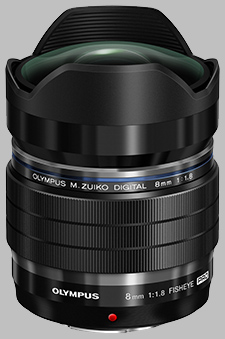
|
|
Your purchases support this site
Buy the Olympus 8mm f/1.8 Pro M.Zuiko Digital ED Fisheye
SLRgear Review
May 29, 2015
by Andrew Alexander
Olympus introduced the 8mm ƒ/1.8 Pro M.Zuiko Digital ED Fisheye in May 2015, an expensive and complicated lens capable of producing a 180 degree field of view. The lens offers the equivalent of a 16mm fisheye (in 35mm film terms) in a tiny package weighing just over 300 grams.
The lens is compatible with cameras in the Micro Four-Thirds mount system. Unfortunately, due to the fisheye effect our testing software couldn't make heads or tails of the data, so this review will be more anecdotal in nature.
The Olympus 8mm M.Zuiko fisheye lens ships with a lens cap that fits in place over the built-in lens hood; it retails for approximately $1,000. For more details about the lens release you can also read our article at The Imaging Resource.
Sharpness
Below, you'll see in place of our regular test charts a gallery of sample images shot with the Olympus 8mm M.Zuiko fisheye lens, on the Panasonic DMC-GX1 camera, which is our standard Micro Four-Thirds test camera. Images shot with the lens offer pleasing sharpness; corners are often out of focus in wide-aperture (ƒ/1.8) shots because of the subject distance, rather than characteristics of the lens. It doesn't take much to get the full frame of a scene in focus - just back up and stop down a few aperture stops.
Chromatic Aberration
If there's a problem with the lens, it's perhaps excessive chromatic aberration. It's less evident as the lens is stopped down, but in our landscape scenes, it's not hard to see color fringing in areas of high contrast.
Shading (''Vignetting'')
It's hard to detect any corner shading at all in our gallery images.
Distortion
Oh yes, there is significant barrel distortion, but that's a fisheye lens for you. The effect is maximized the closer you are to the subject, so getting some distance is the easiest way to offset this distortion.
Out of curiosity, I wanted to see if we could remove the distortion by applying multiple levels of distortion correction in Photoshop; four rounds custom distortion correction later, we arrived at the last image in the gallery below...
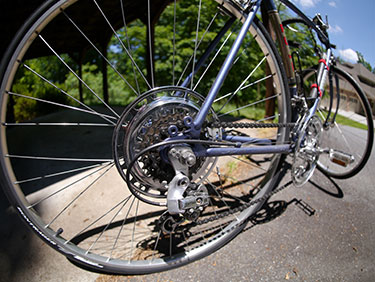 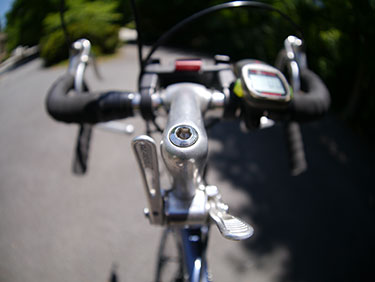   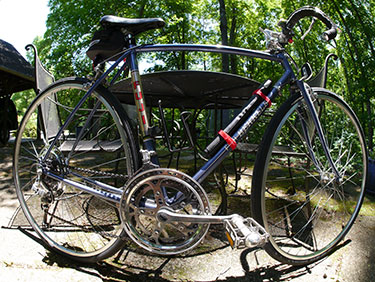 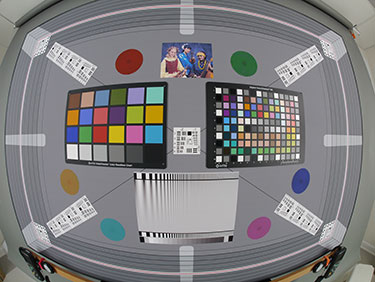 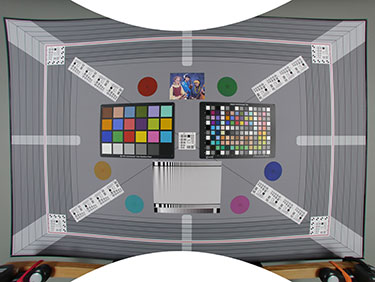
|
Autofocus Operation
The Olympus 8mm M.Zuiko fisheye offers fast autofocus results, going from close-focus to infinity in less than one second.
Build Quality and Handling
The Olympus 8mm M.Zuiko fisheye lens is a complex lens: it is composed of 17 lens elements in 15 groups, including 1 Aspherical, 3 Super ED, 2 ED, 1 Super HR, and 2 HR elements. All of this in a small (3" long) package that weighs around 11 ounces (313 grams). The lens is compact, but it has a nice solid heft to it. The lens offers a maximum aperture of ƒ/1.8, and is made up of seven rounded blades.
The lens is built with metal construction and a metal lens mount; there are no filter threads to attach filters, on account of the bulbous front element that makes it possible to get the 180 degree field of view. There's also no gel filter holder on the rear side, either, and other than the focusing ring, there are no switches or readouts of any kind.
The focusing ring is about an inch wide, made of a ribbed plastic that is easy to turn. The ring will turn forever in either direction with no soft or hard stops.
Olympus claims the lens is weather sealed in five separate locations and freeze proof down to 14F/-10C. A ZERO coating helps to eliminate ghosts and flare. A pinch type cap covers the bulbous front element for protection.
Olympus has also announced a dedicated underwater housing for the E-M1, the PT-EP11, as well as firmware updates for the E-M1 and E-M5 II that offer color correction options for underwater settings.
Alternatives
Olympus 8mm ƒ/3.5 Zuiko Digital Fisheye ~$650
We haven't reviewed this lens, and if you wanted to use it on your Micro Four-Thirds camera you'd need a four-thirds to Micro Four-Thirds adapter like Olympus' MM-3. It would make for a clunkier package though, and the maximum aperture is much larger (ƒ/3.5 compared to ƒ/1.8).
Panasonic 8mm ƒ/3.5 LUMIX G FISHEYE ~$640
We also haven't reviewed Panasonic's 8mm fisheye, which is also a ƒ/3.5 optic; in this case, it's built for the Panasonic Micro Four-Thirds mount.
Conclusion
If you're looking for a fisheye lens that offers a very wide aperture in the Micro Four-Thirds mount, at the time of writing, this is the lens to get; it's a very specialized lens, offering a dramatically different point of view.
Product Photos
 |
 |
 |
 |
 |
Sample Photos
Click here for more sample images on our Flickr page!
Olympus 8mm f/1.8 Pro M.Zuiko Digital ED Fisheye
Your purchases support this site
Micro Four Thirds - Black
Olympus 8mm f/1.8 Pro M.Zuiko Digital ED Fisheye User Reviews
The Olympus 8mm f/1.8 Pro M.Zuiko Digital ED Fisheye doesn't have any user reviews yet!